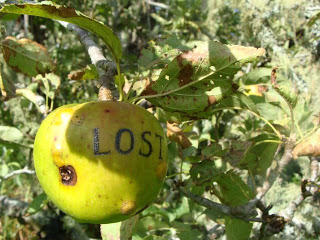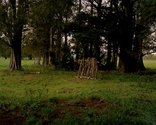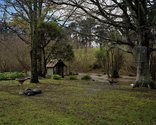John Hurrell – 22 May, 2009
If art needs a social environs to function (and admittedly I'm not entirely convinced that it does) these apples should be where people can discover them in a non-art context and be surprised. If that is not the point, but notions of decay and life's transience are, then she needs to think about how nature's processes interact with the meaning of the words. Her texts and images come from all over the place and lack focus. She is fetishising technique and ignoring content.
There are two shows here. One - in the back room - is a group of three large framed photographs; two high definition inkjet prints of tree-filled landscapes and one of Lake Rotorua. The other out front, presents a kauri table bearing over a hundred and fifty rotting apples that have all been tattooed. There is also a coloured photograph of a few of them, and there is a video on the floor (viewable only through a cardboard fruit-box placed on its side) of two walks, at dusk and dawn, around the perimeters of an old orchard.
These exhibitions are quite different. It’s odd that they have been juxtaposed together.
Karen Crisp’s very precise coloured images first impressed me in a Bath Street group show last year. These photographs too are remarkable. They have a subtle dreamlike (or fairytale) quality, a sense of otherworldliness. Their haunting atmosphere draws you back for repeated viewings - for their dimension of strange ‘oddness’ is hard to put your finger on. They are not creepy, just very mysterious. Nor are they ‘over the top.’ Everything is tightly controlled, nuanced and discreet.
Tabatha Forbes’ work to me seems unresolved. The many apples she tattooed should never have been taken off the orchard trees but engraved on site and left to drop naturally. The show is called Outside and that is where it should have stayed. That is where the power of her idea could have been fulfilled.
Here’s why: If art needs a social environs to function (and admittedly I’m not entirely convinced that it does) these apples should be where people can discover them in a non-art context and be surprised. If that is not the point, but notions of decay and life’s transience (in the Dutch still-life tradition) are, then she needs to think about how nature’s processes interact with the meaning of the words. Her texts and images come from all over the place and lack focus. She is fetishising technique and ignoring content.
John Hurrell



 Advertising in this column
Advertising in this column Two Rooms presents a program of residencies and projects
Two Rooms presents a program of residencies and projects



This Discussion has 0 comments.
Comment
Participate
Register to Participate.
Sign in
Sign in to an existing account.